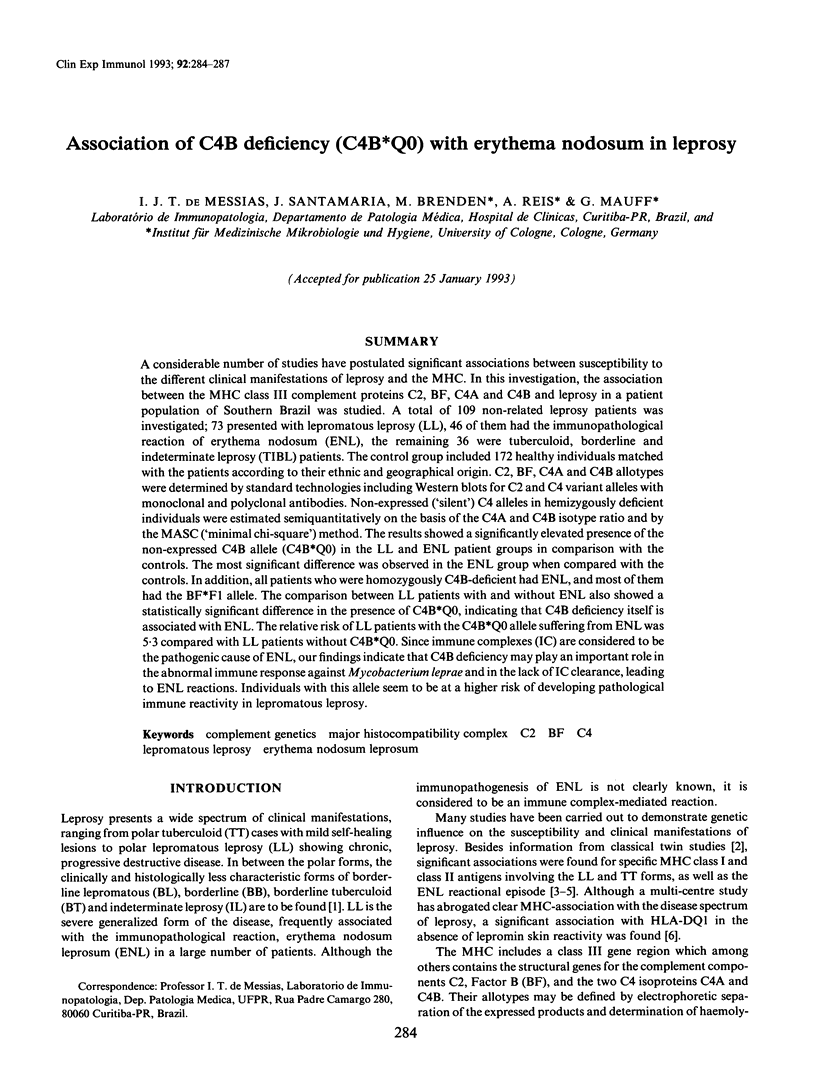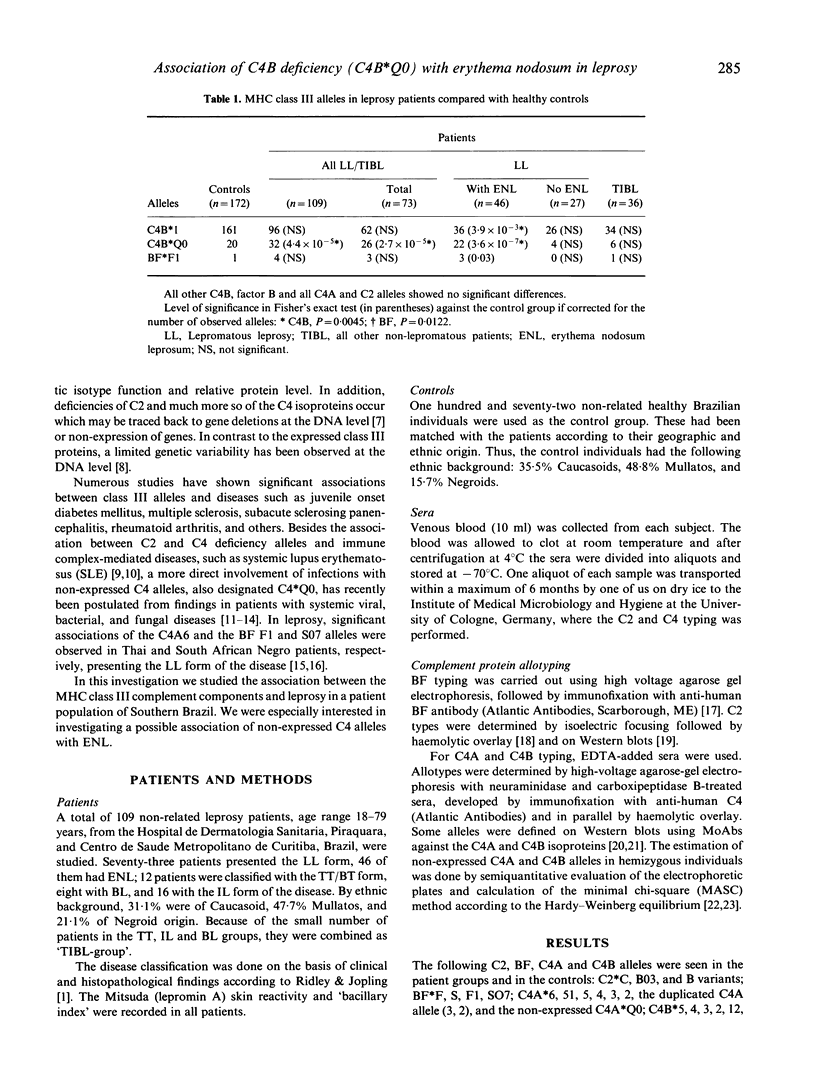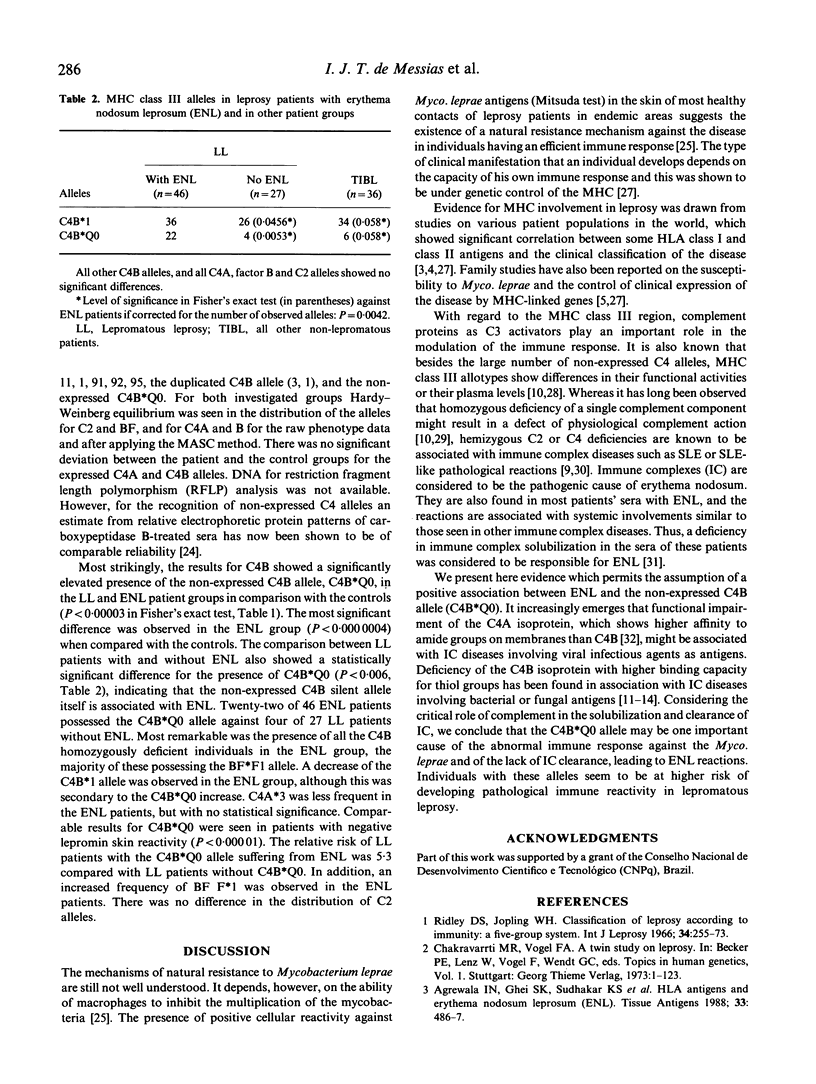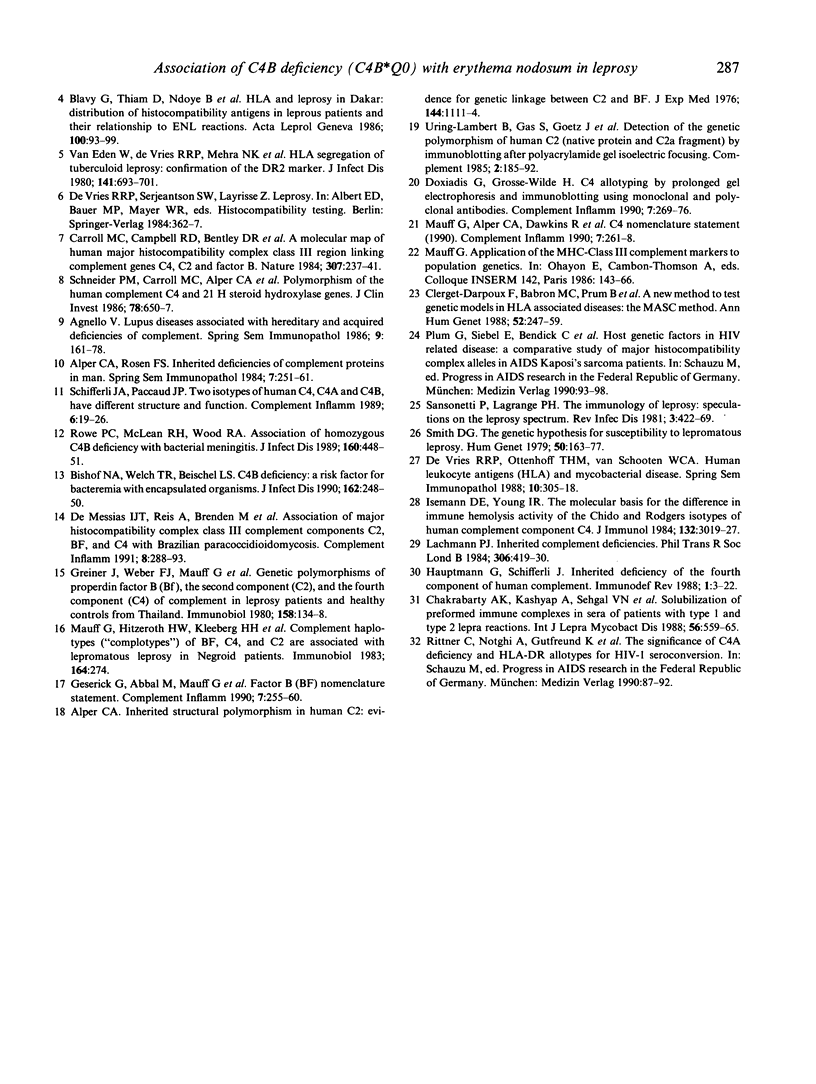Abstract
A considerable number of studies have postulated significant associations between susceptibility to the different clinical manifestations of leprosy and the MHC. In this investigation, the association between the MHC class III complement proteins C2, BF, C4A and C4B and leprosy in a patient population of Southern Brazil was studied. A total of 109 non-related leprosy patients was investigated; 73 presented with lepromatous leprosy (LL), 46 of them had the immunopathological reaction of erythema nodosum (ENL), the remaining 36 were tuberculoid, borderline and indeterminate leprosy (TIBL) patients. The control group included 172 healthy individuals matched with the patients according to their ethnic and geographical origin. C2, BF, C4A and C4B allotypes were determined by standard technologies including Western blots for C2 and C4 variant alleles with monoclonal and polyclonal antibodies. Non-expressed ('silent') C4 alleles in hemizygously deficient individuals were estimated semiquantitatively on the basis of the C4A and C4B isotype ratio and by the MASC ('minimal chi-square') method. The results showed a significantly elevated presence of the non-expressed C4B allele (C4B*Q0) in the LL and ENL patient groups in comparison with the controls. The most significant difference was observed in the ENL group when compared with the controls. In addition, all patients who were homozygously C4B-deficient had ENL, and most of them had the BF*F1 allele. The comparison between LL patients with and without ENL also showed a statistically significant difference in the presence of C4B*Q0, indicating that C4B deficiency itself is associated with ENL. The relative risk of LL patients with the C4B*Q0 allele suffering from ENL was 5.3 compared with LL patients without C4B*Q0. Since immune complexes (IC) are considered to be the pathogenic cause of ENL, our findings indicate that C4B deficiency may play an important role in the abnormal immune response against Mycobacterium leprae and in the lack of IC clearance, leading to ENL reactions. Individuals with this allele seem to be at a higher risk of developing pathological immune reactivity in lepromatous leprosy.
Full text
PDF



Selected References
These references are in PubMed. This may not be the complete list of references from this article.
- Agnello V. Lupus diseases associated with hereditary and acquired deficiencies of complement. Springer Semin Immunopathol. 1986;9(2-3):161–178. doi: 10.1007/BF02099020. [DOI] [PubMed] [Google Scholar]
- Agrewala J. N., Ghei S. K., Sudhakar K. S., Girdhar B. K., Sengupta U. HLA antigens and erythema nodosum leprosum (ENL). Tissue Antigens. 1989 Apr;33(4):486–487. doi: 10.1111/j.1399-0039.1989.tb01697.x. [DOI] [PubMed] [Google Scholar]
- Alper C. A. Inherited structural polymorphism in human C2: evidence for genetic linkage between C2 and Bf. J Exp Med. 1976 Oct 1;144(4):1111–1115. doi: 10.1084/jem.144.4.1111. [DOI] [PMC free article] [PubMed] [Google Scholar]
- Alper C. A., Rosen F. S. Inherited deficiencies of complement proteins in man. Springer Semin Immunopathol. 1984;7(2-3):251–261. doi: 10.1007/BF01893022. [DOI] [PubMed] [Google Scholar]
- Bishof N. A., Welch T. R., Beischel L. S. C4B deficiency: a risk factor for bacteremia with encapsulated organisms. J Infect Dis. 1990 Jul;162(1):248–250. doi: 10.1093/infdis/162.1.248. [DOI] [PubMed] [Google Scholar]
- Blavy G., Thiam D., Ndoye B., Diakhate L., Millan J. HLA et lèpre à Dakar: répartition des antigènes d'histocompatibilité chez le lépromateux et relation avec les réactions ENL. Acta Leprol. 1986 Jan-Mar;4(1):93–99. [PubMed] [Google Scholar]
- Carroll M. C., Campbell R. D., Bentley D. R., Porter R. R. A molecular map of the human major histocompatibility complex class III region linking complement genes C4, C2 and factor B. Nature. 1984 Jan 19;307(5948):237–241. doi: 10.1038/307237a0. [DOI] [PubMed] [Google Scholar]
- Chakrabarty A. K., Kashyap A., Sehgal V. N., Saha K. Solubilization of preformed immune complexes in sera of patients with type 1 and type 2 lepra reactions. Int J Lepr Other Mycobact Dis. 1988 Dec;56(4):559–565. [PubMed] [Google Scholar]
- Clerget-Darpoux F., Babron M. C., Prum B., Lathrop G. M., Deschamps I., Hors J. A new method to test genetic models in HLA associated diseases: the MASC method. Ann Hum Genet. 1988 Jul;52(Pt 3):247–258. doi: 10.1111/j.1469-1809.1988.tb01102.x. [DOI] [PubMed] [Google Scholar]
- Doxiadis G., Grosse-Wilde H. C4 allotyping by prolonged gel electrophoresis and immunoblotting using monoclonal and polyclonal antibodies. Complement Inflamm. 1990;7(4-6):269–276. doi: 10.1159/000463160. [DOI] [PubMed] [Google Scholar]
- Geserick G., Abbal M., Mauff G., Siemens I. Factor B (BF) nomenclature statement. Complement Inflamm. 1990;7(4-6):255–260. doi: 10.1159/000463158. [DOI] [PubMed] [Google Scholar]
- Greiner J., Weber F. J., Mauff G., Baur M. Genetic polymorphisms of properdin factor B(Bf), the second component (C2), and the fourth component (C4) of complement in leprosy patients and healthy controls from Thailand. Immunobiology. 1980;158(1-2):134–138. doi: 10.1016/S0171-2985(80)80053-2. [DOI] [PubMed] [Google Scholar]
- Hauptmann G., Tappeiner G., Schifferli J. A. Inherited deficiency of the fourth component of human complement. Immunodefic Rev. 1988;1(1):3–22. [PubMed] [Google Scholar]
- Isenman D. E., Young J. R. The molecular basis for the difference in immune hemolysis activity of the Chido and Rodgers isotypes of human complement component C4. J Immunol. 1984 Jun;132(6):3019–3027. [PubMed] [Google Scholar]
- Lachmann P. J. Inherited complement deficiencies. Philos Trans R Soc Lond B Biol Sci. 1984 Sep 6;306(1129):419–430. doi: 10.1098/rstb.1984.0102. [DOI] [PubMed] [Google Scholar]
- Mauff G., Alper C. A., Dawkins R., Doxiadis G., Giles C. M., Hauptmann G., Rittner C., Schneider P. M. C4 nomenclature statement (1990). Complement Inflamm. 1990;7(4-6):261–268. doi: 10.1159/000463159. [DOI] [PubMed] [Google Scholar]
- Ridley D. S., Jopling W. H. Classification of leprosy according to immunity. A five-group system. Int J Lepr Other Mycobact Dis. 1966 Jul-Sep;34(3):255–273. [PubMed] [Google Scholar]
- Rowe P. C., McLean R. H., Wood R. A., Leggiadro R. J., Winkelstein J. A. Association of homozygous C4B deficiency with bacterial meningitis. J Infect Dis. 1989 Sep;160(3):448–451. doi: 10.1093/infdis/160.3.448. [DOI] [PubMed] [Google Scholar]
- Sansonetti P., Lagrange P. H. The immunology of leprosy: speculations on the leprosy spectrum. Rev Infect Dis. 1981 May-Jun;3(3):422–469. doi: 10.1093/clinids/3.3.422. [DOI] [PubMed] [Google Scholar]
- Schifferli J. A., Paccaud J. P. Two isotypes of human C4, C4A and C4B have different structure and function. Complement Inflamm. 1989;6(1):19–26. doi: 10.1159/000463068. [DOI] [PubMed] [Google Scholar]
- Schneider P. M., Carroll M. C., Alper C. A., Rittner C., Whitehead A. S., Yunis E. J., Colten H. R. Polymorphism of the human complement C4 and steroid 21-hydroxylase genes. Restriction fragment length polymorphisms revealing structural deletions, homoduplications, and size variants. J Clin Invest. 1986 Sep;78(3):650–657. doi: 10.1172/JCI112623. [DOI] [PMC free article] [PubMed] [Google Scholar]
- Smith D. G. The genetic hypothesis for susceptibility to lepromatous leprosy. Hum Genet. 1979;50(2):163–177. doi: 10.1007/BF00390238. [DOI] [PubMed] [Google Scholar]
- Uring-Lambert B., Gas S., Goetz J., Mauff G., Goldmann S. F., Frössler M., Bender K., Hauptmann G. Detection of the genetic polymorphism of human C2 (native protein and C2a fragment) by immunoblotting after polyacrylamide gel isoelectric focusing. Complement. 1985;2(4):185–192. doi: 10.1159/000467861. [DOI] [PubMed] [Google Scholar]
- de Messias I. J., Reis A., Brenden M., Queiroz-Telles F., Mauff G. Association of major histocompatibility complex class III complement components C2, BF, and C4 with Brazilian paracoccidioidomycosis. Complement Inflamm. 1991;8(5-6):288–293. doi: 10.1159/000463198. [DOI] [PubMed] [Google Scholar]
- de Vries R. R., Ottenhoff T. H., van Schooten W. C. Human leukocyte antigens (HLA) and mycobacterial disease. Springer Semin Immunopathol. 1988;10(4):305–318. doi: 10.1007/BF02053843. [DOI] [PubMed] [Google Scholar]
- van Eden W., de Vries R. R., Mehra N. K., Vaidya M. C., D'Amaro J., van Rood J. J. HLA segregation of tuberculoid leprosy: confirmation of the DR2 marker. J Infect Dis. 1980 Jun;141(6):693–701. doi: 10.1093/infdis/141.6.693. [DOI] [PubMed] [Google Scholar]


